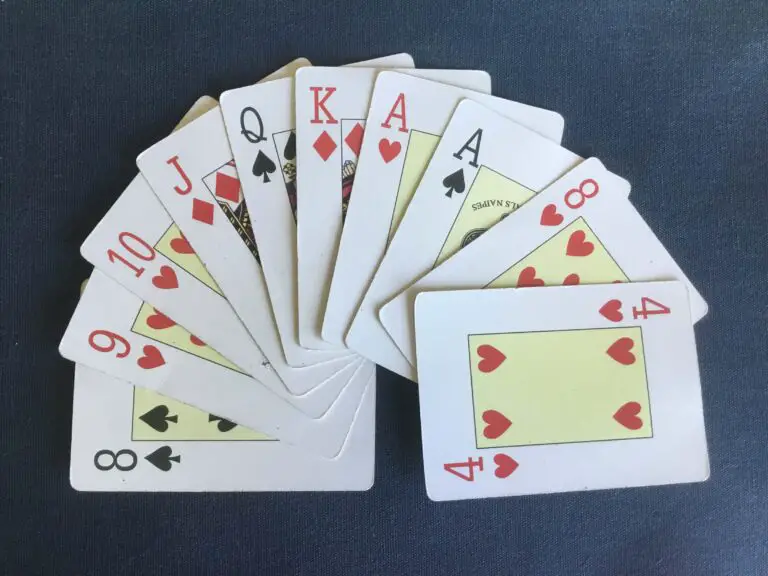Sometimes the simplest games are the best. I’ve fallen into the trap of thinking elaborate design and copious materials directly improve my students’ learning, but, really, you can achieve wonderful things with no extra preparation at all.
That’s not to say you should never use high-quality resources. It’s just sometimes you’ll spend so long putting it all together only to be disappointed when it fails to have the desired effect.
Nor am I saying you should forget about planning and preparation classes and instead rely on no-prep games to fill time. Absolutely not. However, occasionally, things won’t go according to plan, and you’ll need to adapt on the fly. The 9 games in this list help you do just that.

All 9 of them can be played without any materials at all, although one or two work best with some paper and a pen/pencil. So let’s get to the games!
- Hot Potato
- 21 (or 51, or 210)
- Alibi
- What Are You Doing?
- Memory Chain
- Two Truths and a Lie
- What’s Changed?
- Alphabet Race
- Psychiatrist
I’ve never been a fan of spending lots of time and money on games when you can get the same results for free. That’s why my ebook of 20 EFL/ESL games is full of games that only need the most basic of resources, and many don’t need any preparation at all.
You can get the free ebook by signing up to the Enchanted ESL Newsletter. Subscribers also get access to lots more exclusive resources, as well as monthly emails with role-play scenarios, lesson plans and even more games. All for no cost at all!
1. Hot Potato
This is my number one no-prep game. It’s perfect for practicing vocab at the start or end of a lesson, and children never tire of the high energy and excitement. Perhaps best avoided with serious/shy adults.
Estimated time: 5-10 minutes
Energy level: 4/5
English level: Beginner, Intermediate and Advanced
How to play
Everyone stands in a circle
Select a category which has plenty of words, for example: animals, food, clothes, etc.
The first person takes the imaginary hot potato and mimes juggling it with both their hands so they don’t get burned.
They say a word in the category, then pass the hot potato to the player on their left. Likewise, that player has to say a word in the category before passing it on, and play continues around the circle.
If a player repeats a word already said, or can’t think of a word in a reasonable time (5-10 seconds), they are BURNED. This means they only have one hand to juggle the potato. If they get burned again, they have to juggle the potato on their head only.
Any more burns, and they’re out of the game. Play ends when only one player is left standing (or, more likely, you run out of time in the class).
I prefer playing the game with an imaginary hot potato. Some people play it with a ball, but that can slow things down as people drop the ball and have to run around the collect it.
Silliness is encouraged when trying to hold the hot potato. Kids love the excitement of it, but make sure it doesn’t get out of control.
TIPS
- Join the game and use it as an opportunity to introduce new words
- Apply the benefit of the doubt if you can’t remember whether a word has already been said.
- Stand up and go outside if possible.
- Help students get into the habit of thinking of one or two words when it’s not their turn, so they’re ready to say something when it comes round to them.
- If possible, play in groups of 5-10
2. 21 (or 51, or 210)
A great game for practicing numbers. It can be a challenge for younger kids who aren’t comfortable with numbers in their own language.
Estimated time: 5 minutes
Energy level: 3/5
English level: Beginner (but not young children), Intermediate and Advanced

The great thing about this game is you can switch from the normal 0-21 to practice a different range, e.g. 30-51 or go up in tens from 10 to 210. As long as there are 21 numbers in play, it doesn’t really matter which ones they are.
How to play
Organise everyone so it’s clear the order of turns (ideally a circle). The first player starts at 1. Each player can say one, two, or three numbers.
If they say one number (e.g. “one”), the turn passes to the next person in a clockwise direction. If they say two numbers (“five, six”), the direction of play reverses and the turn passes to the previous player. If they say three numbers (“nine, ten, eleven”), the turn skips the next person and goes to the player after them.
Play continues until someone is forced to say the number “twenty-one” (or whichever number your game ends at). That player then has to do a “punishment”, e.g. talk for 30 seconds about a topic.
Suggested rules: If someone says two numbers (e.g. “five, six”), the next person can’t also say two numbers – they have to say one number or three numbers. The same applies to saying three numbers.
Extra fun rule (advanced students): Each round, someone (could be the loser of the last round) creates a new rule. For example, instead of saying “five” you have to say a colour. Or, if you’re feeling really confident, the new rule could be to reverse the order of the numbers.
If you’re familiar with this game (it’s a common drinking game), the rules here should make sense. If not, and my brief description of the rules isn’t enough, here’s a link to the rules for the drinking game on wikipedia.
TIPS:
- Make “punishments” related to English and not too stressful. Talking about something for 30 seconds works for most classes. Another option is having to say all the numbers in reverse order.
- Mistakes during the game, like talking out of turn, or saying an incorrect number, shouldn’t be a problem. If they’re becoming too frequent, think up a minor “punishment”.
- If you’ve got adults who have quick minds, you can get really creative with the added rules. For example, on multiples of four, they have to stand up and do a dance and on multiples of five, they have to shout the number (see if they remember to do both on 20).
- The game works best in groups of 5-8. Split larger classes into groups. If you can’t do this, extend the range of numbers, so each student gets a couple of turns.
3. Alibi
An EFL/ESL teacher’s favourite, Alibi is best with some paper and a pen/pencil for the police teams but can be done without if your students have good memories. It’s longer than the other games on this list, and can take up a whole session if needed.
Estimated time: 30-40 minutes
Energy level: 2/5
English level: Intermediate and Advanced
In an ideal world, you would have two separate rooms, but if you don’t, no worries. 4 players are required as a minimum, and it works best with 6-10. If you have a large class, run two or three games in parallel.
How to play
Part 1
Select two students to be criminals. They have committed a crime (a murder in Paris, arson in Beijing… whatever you want) and will be questioned by police detectives.
The criminals go outside the room, or somewhere out of earshot. Give them 10 minutes to agree on a false alibi for the day of the crime. The only rules are that they spent the whole day together and went to 3 separate places.
Divide the other students into two police teams. Their job is to find flaws in the alibis by preparing and asking clever questions. They are aware the criminals went to 3 places and spent the whole day together, and must think about how they can find inconsistencies.
Part 2
Each police team questions one criminal. If you have two rooms available, put a police team in each, so the criminals have no way of communicating with each other.
For 5 minutes, detectives ask questions to the criminals. If you have paper and pens/pencils, encourage them to take notes.
Important: “I don’t know” or equivalent answers from the criminal are not allowed. They must give tangible information. They must also answer quickly, without stalling for time.
After five minutes, switch the criminals so they talk to the other police team. Repeat the questioning with the detectives attempting to identify inconsistencies between the two alibis.
Resolution
Police teams look at their notes. They need to identify 3 differences between what the criminals said in order to put them in prison (and win the game). If they can’t do this, the proof is insufficient and the criminals win!
TIPS:
- If the criminals always get caught, increase the number of inconsistencies required to 5 instead of 3. In contrast, if the police are struggling, reduce it to 2.
- Enforce the time limits without negotiation. If you want to shorten the game, give less time to the criminals to come up with an alibi.
- Suggest a few probing questions like, “What were you both wearing?”
4. What Are You Doing?
A nice active game which practices verbs and the present continuous (or past continuous with the variation “what were you doing?”).
Estimated time: 10-15 minutes
Energy level: 4/5
English level: Beginner and Intermediate

How to play
Select 4 students to stand at the front and be the actors. The rest are guessers.
Guessers close their eyes and actors silently do an action e.g. sleeping, playing basketball, drinking water.
After a few seconds, shout “STOP!” at the actors, who must freeze in their current position. Now, guessers can look. They should try to guess what the actors are doing (or were doing) using the present/past continuous.
For example, “Ken is singing.”
After all the actions have been guessed, choose a different set of actors and repeat.
TIPS:
- Actors can team up to represent actions together, like “they are hugging”.
- To practice specific vocab, e.g. sports, only allow actions related to the topic.
- Feel free to be an actor yourself. In this way, you can gently show students some new vocabulary like “yawning” or “shivering”.
5. Memory Chain
Memory Chain is a powerful way of embedding vocabulary through the use of gestures. To learn about gestures, read my article How to Use Gestures to Embed Vocab in EFL/ESL and discover the power of this super simple game.
Estimated time: 10-15 minutes
Energy level: 3/5
English level: Beginner, Intermediate and Advanced
How to play
Establish a clear order of turns (ideally sitting in a circle)
Begin the chain with a starter sentence e.g. “I went to the supermarket, and I bought ________”. Add the first word to the chain, for example, “some strawberries”.
The next person repeats what you said and extends the chain with another word. For example, “I went to the supermarket, and I bought some strawberries and a bag of potatoes.”
Keep going like this, extending the chain further and further, until you run out of time time or you can’t remember the chain anymore.
This is not a competition. In fact, it works much better as a collaborative endeavour, with other students allowed to use gestures as reminders. The gestures also help make the chain much longer. It’s exciting to see the chain getting bigger and bigger, and everyone gets invested in its success.

TIPS
- Set the vocab topic with the starter sentence. Learning about nature? “I took a walk in the forest and I found _________”. What about sports? “I was watching the Olympics and I saw ________”.
- Praise advanced vocabulary rather than basic words that students are already confident with. Maybe consider banning some words if they’re too easy.
- Encourage confident students to come up with phrases like “a kilogram of juicy strawberries” rather than “some strawberries”.
6. Two Truths and a Lie
You’ll find this game much easier with paper and pencils for each student, but it can be done on a blackboard or even orally with more advanced learners.
Estimated time: 10-15 minutes per round
Energy level: 2/5
English level: Intermediate and Advanced
5-8 students is the best group size, but it can be done with anywhere between 2 and 15.
How to play
All players write (or say if you’re doing it orally) three sentences about themselves. Two are true, one is a lie.
Taking it in turns, students read their sentences. Everyone else has to decide which one is the lie. Encourage questions, but those guessing should keep their answers to themselves (especially if they know for sure which one is not true).
Players reveal which sentence they chose as a lie. Correct guesses earn a point. For each incorrect guess, the person who wrote the sentences gets one point.
Keep going until everyone has shown their sentences. Most points wins.

TIPS:
- Avoid overly personal and sensitive information.
- Praise the use of creative sentences.
- Join in! Students enjoy getting to know about you through this game, and you can introduce different sentence structures and vocabulary.
7. What’s Changed?
A super simple game for beginner students. It’s like Spot the Difference, but with a real-life twist.
Estimated time: 5 minutes per round
Energy level: 5/5
English level: Beginner and Intermediate
How to play
Choose one student (the identifier) to look at the room for a few seconds, then go out. Give the students left in the room a few minutes to change some things (rearrange chairs, turn posters upside down, etc.). Get the identifier back inside and ask them what has changed.
Absolute beginners may only be able to point and name the object that has changed, e.g. “chairs”. Encourage more confident students to give more detail, like “chairs moved”, or even “they changed the position of the chairs”.
TIPS:
- Set clear expectations before beginning. Respect for people’s possessions and safety of everyone in the classroom comes first. Also, make sure they put everything back to normal at the end.
- Don’t change too much. 8-12 changes are sufficient. If you have a class of 30, choose 3 identifiers and only allow the others to change one thing each.
- Make a note on the board of any new vocabulary so you can learn it later.
- Put a time limit on the identifiers so they have to find changes quickly.
8. Alphabet Race
Possibly the simplest game on this list, and it requires no setup whatsoever. If you have a timer, you can record how long it takes students to get through the alphabet, but this is totally optional.
Estimated time: 2 minutes (although you can repeat it several times)
Energy level: 4/5
English level: Beginner and Intermediate
How to play
Establish a clear turn order (ideally standing in a circle). Choose a student to start – they say “A”, then the next in turn says “B”, then “C”, etc. Keep going until someone makes a mistake (start again), or you make it all the way to Z.

You’d be surprised how many intermediate level students can’t remember letters like “G” and “J”, so make sure you’ve practiced the alphabet with them a few times before.
TIPS:
- When someone makes a mistake, start with the student after the one who got it wrong isntead of going back to the first in line.
- Avoid blaming or criticising students for messing up and encourage them instead.
- For more advanced students, instead of saying the letter, have them say a word beginning with that letter.
- Up the difficulty by saying the alphabet in reverse order.
9. Psychiatrist
This game is sure to get your students laughing. It requires zero preparation and can last five minutes or fifty minutes if you do several rounds.
Estimated time: 5-10 minutes per round
Energy level: 3/5
English level: Beginner, Intermediate and Advanced
How to play
Choose one student to be the psychiatrist (you may want to choose 2 or 3 if you have a big class). They go out of the room and wait.
Everyone else is a patient. They should all agree on a shared “condition”. For example, they think they are in Australia, or they shout the second word of each sentence. Make sure all students understand the condition.
The psychiatrist comes back into the classroom while the other students are in character. The psychiatrist should ask questions to the patients who must respond in a way that reflects their condition (referencing Australian things or shouting the second word of each sentence).
Give the psychiatrist a few minutes to figure out the condition and congratulate them when they do.
TIPS:
- Keep silliness under control. It can be great fun to act out crazy conditions, but make sure the point of the game isn’t lost.
- Check every condition is appropriate before everyone agrees to it.
- If psychiatrists aren’t asking the right questions, steer them towards the target.
Adapt and Improvise
Every class is unique. Depending on who you teach, these games will look very different. That means you can’t apply the same exact rules and tips to every situation. Instead, you must alter them to suit your needs.
That’s part of the joy of teaching. And especially when you have no time to prepare, flexibility and thinking on the spot are key skills. Nobody owns these games. Use them how and where you like, and feel free to come up with your own variations.
For more free games, get a copy of my ebook of 20 EFL/ESL games by signing up to the Enchanted ESL Newsletter. You’ll also get your hands on lots of other free resources, and receive monthly emails with role-play scenarios, lesson plans and even more games!
If you’re looking for more games and activities, check out my other lists:
9 EFL/ESL Speaking Games & Activities Perfect for Beginners
9 EFL/ESL Games & Activities for Intermediate Learners
9 EFL/ESL Games and Activities for Advanced Learners
9 High Energy EFL/ESL Games for Boosting Vocabulary
9 Engaging Homework Ideas for EFL/ESL: No worksheets!
9 Exciting EFL/ESL Activities for Writing & Spelling
9 Fun EFL/ESL Games & Ideas With Standard Playing Cards
9 EFL/ESL Games With No Materials or Preparation Needed
9 EFL/ESL 5 Minute Games Every Teacher Needs to Know
9 Superb EFL/ESL Games & Activities Using Just Pen & Paper
9 Classy EFL/ESL Games & Activities for Adults (+ tips)
9 Confidence-Boosting EFL/ESL Speaking Games for All Levels
9 Exciting Flashcard Games for EFL/ESL Classes








